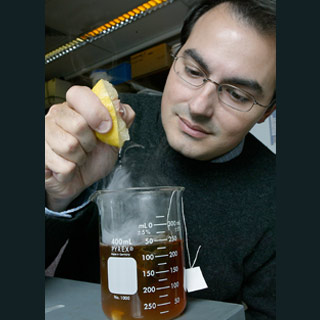
A digestion model with human intestinal cells may be adapted to explain that adding ascorbic acid to green tea may raise the absorbability of catechins found in the tea. Catechins, a class of polyphenols general in tea, cocoa and grape, are antioxidants claimed to combat heart disease, stroke, cancer, diabetes and other health problems. This was as per Mario Ferruzzi, associate professor of food science and nutrition.
Ferruzzi, Elsa Janle, a Purdue associate research professor of foods and nutrition, and Catrina Peters, a Purdue graduate student in nutrition, were apparently able to show that adding ascorbic acid, sucrose or both together increases by as much as three times the quantity of catechins that could be absorbed into the bloodstream. The outcome of the in vivo study matched up well with those envisaged by the in vitro model.
Ferruzzi commented, “This model may be used as a pre-emptive screening tool at very little cost before you do expensive tests on animals or humans. If you want to get human screening off the ground, it takes months. If you want to use this model, it takes hours.â€
The model plans how the digestive stability, solubility and absorption of polyphenols apparently varies based on alteration to a beverage’s formula. It may not be accurate in terms of dimensions, but when contrasted to the in vivo test in rats, the model’s guess could coordinate directionally to the in vivo study and was comparatively close proportionately.
Ferruzzi mentioned that testing with the model could let researchers foretell how a latest product formula might alter the product’s properties, decreasing the amount of animals required for testing to only products that may demonstrate preferred uniqueness in the model. The model could also be modified to replicate the digestive characteristics of other animals or humans as initially planned.
Ferruzzi quoted, “As long as we know the typical gastrointestinal conditions of an animal and the volumes, we can adapt the model to mimic those conditions. You don’t have to do expensive precursor studies.â€
The in vivo study supported the model study that apparently demonstrated that adding sugar and vitamin C to green tea improved the body’s capability to absorb polyphenols. Ferruzzi mentioned that adding lemon juice or other citrus juice to tea may do the trick, or customers could look for ready-to-drink products that may have 100 percent of the recommended quantity of vitamin C or ascorbic acid on the ingredient list.
Ferruzzi commented, “Having that vitamin C seems to do it. And if you don’t want to squeeze a lemon into your cup, just have a glass of juice with your green tea.â€
Connie Weaver, head of the National Institutes of Health Purdue University-University of Alabama at Birmingham Botanical Research Center for Age-Related Diseases, stated that the focus of the study was apparently a significant part of understanding how to get the most out of compounds considered valuable.
Weaver remarked that there is a lot of interest in bioactive materials to protect people from disease and promote better health. What’s been totally ignored is the way these materials are found in foods in combination with other ingredients. How they’re involved in the food matrix can affect how people absorb these health promoters.
Ferruzzi mentioned that the next step in the study could be to conduct a human clinical trial.
This study was published in the online edition of the journal Food Research International.
